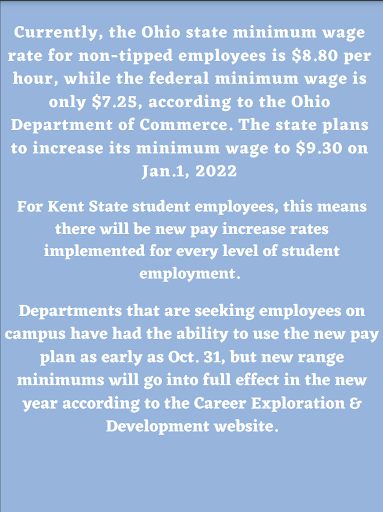Kent State students launch a Fall 2021 awareness campaign that addresses issues in minimum wage

Kent State students launch a Fall 2021 awareness campaign that addresses issues in minimum wage.
December 13, 2021
Kent State students launched a Fall 2021 awareness campaign that addresses issues in minimum wage and advocates for a $15 pay rate for student employees on campus.
“We wanted to pick a topic that we all cared about as a group and that Kent State students would care about, and just an issue that we saw affecting students day to day,” said Megan Medfisch, a senior public relations major. “We definitely saw [student employment] wages being a big factor of that.”
The Living Wage Project acknowledges the impact wage rates can have on one’s mental health and social life.
Medfisch, along with some of her classmates, tackle issues of wage rates in a course titled Media and Movements.
The immersive course explores current social movements through students’ applied skills of communication, research, storytelling, strategy and advocacy. Media and Movements is taught by Stephanie Danes Smith, an associate professor in the School of Media and Journalism.
Students are tasked to develop an awareness campaign that features multiple phases, including a re-imagination event that is meant to exemplify a project focus through hands-on activities and real life scenarios.
For qualitative research, the Living Wage Project had a focus group, student surveys and on-the-spot interviews.
“Students said they face a lot of stress,” Medfisch said. “Think about paying for food, for rent for their apartments and for tuition. They just face a lot of anxiety thinking about the future.”
Students were also asked how they would feel if given the opportunity to make a minimum wage of $15 per hour.
“They said things like relief, satisfaction, joy, happiness [and] freedom,” Medfisch said. “We thought that was really important to show. This is what we really want to get through to people. This is how you could feel if you’re given the opportunity to make this much.”
In the survey, 140 students were asked why having livable wages matters. The data reported about nine in 10 students felt making $15 an hour would improve their quality of life. The majority of students’ said a pay increase would improve their living situations. And nine in 10 students also said making a living wage would help them pay their expenses.
Based on the research, the members of the Living Wage Project were able to create their awareness campaign.
“We had posters to hang up around campus and pass out to students with a QR code leading to our Instagram. … The posters and social media accounts allowed viewers to learn about the Living Wage Simulation and provided details on where/when it would be,” Medfisch wrote in an email. “Our campaign slogan is ‘Low Pay, No Way!’”
To further illustrate their advocacy, the group then developed their re-imagination event, Living Wage versus Your Wage Simulation.
The event was held Nov. 29 and it explored the life of college students making less than $15 an hour.
“It was interesting to explore how beneficial it is for Kent State students [employees] to all make 15 [dollars],” said Brynne Mann, a senior public relations major and group member. “Especially when some of them are limited to the amount of hours they work.”
During the simulation, visitors are assigned fictional student employee personas like Emma, who works part time at Target and Starbucks, lives on campus and pays out of pocket for school.
Participants are given salaries and a $500 emergency fund. They are then met with a series of real-life scenarios, such as budgeting, finances, paychecks and social outings.
Depending on the scenario, participants could gain or lose money, which represents the uncertainty student employees can often face.
At the end of the simulation participants add up their total income and then compare it to Brianna, a persona making a $15 pay rate.
This eye-opening event helped to shed a light on the challenges of students’ work. The classmates overseeing the Living Wage Project want to further that message.
“This isn’t everyone’s situation, but it’s like a majority of students who have to work to provide for themselves,” said London Green, junior journalism major and group member. “I think it kind of opens your eyes up to the different things that people go through in life.”
Alexus Rayzer is a reporter. Contact her at [email protected].











